#translation rna notes
Photo
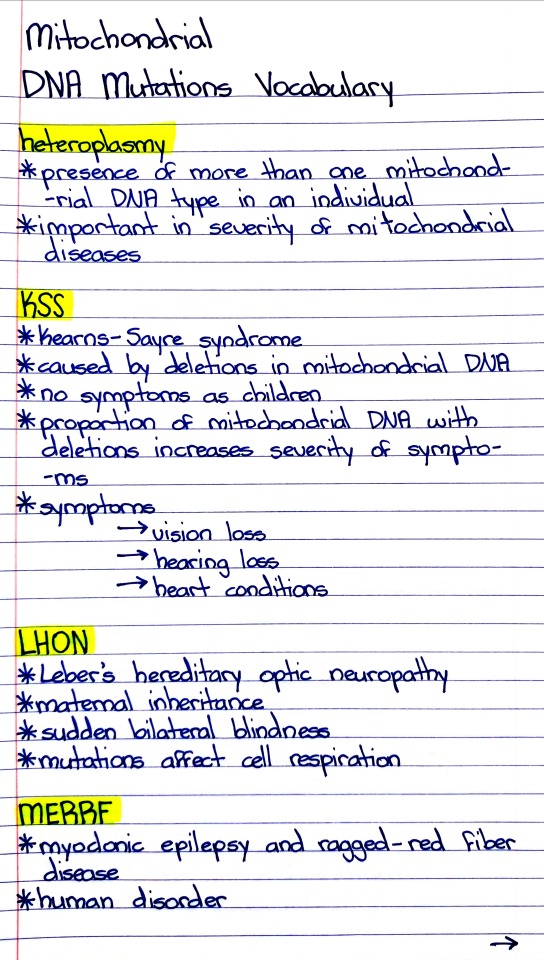
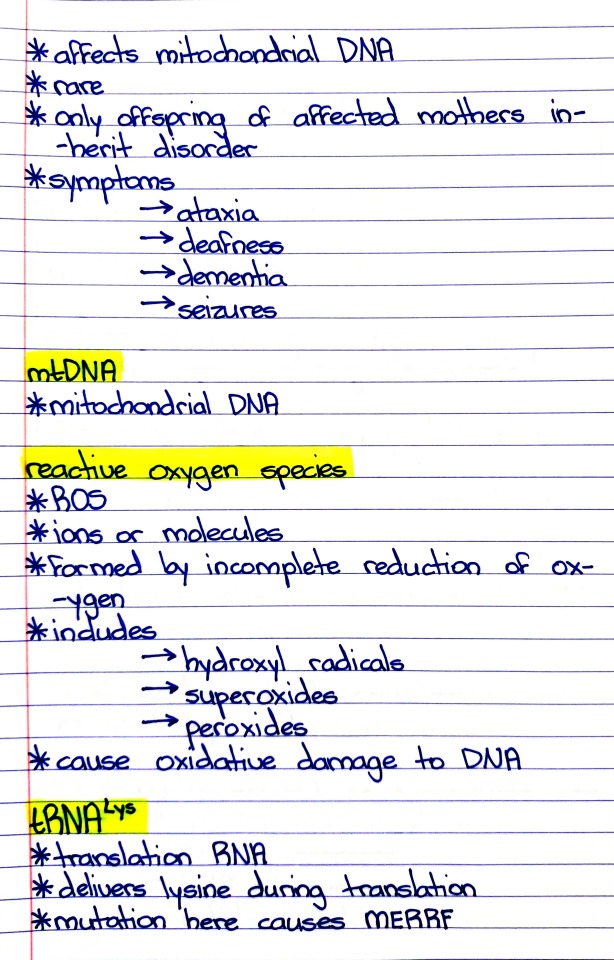
#studyblr#notes#medblr#medical notes#med notes#mtdna#trna#rna#rna notes#dna#dna notes#genetics#genetics notes#translation rna#translation rna notes#mitochondria#mitochondrial mutation#mitochondrial mutations#mitochondrial dna#mitochondrial dna notes#peroxides#superoxides#reactive oxygen species
3 notes
·
View notes
Text
Seriously, genetics is weird.
I was reading one paper on long noncoding RNAs and there's this one part that just really stood out to me.
So to catch everyone up, genetic data is stored as DNA. Then parts of it go through a process called transcription to build a strand of RNA. Certain RNAs get translated into proteins, but there are noncoding RNAs that don't make proteins but instead do a secret second thing (and I mean secret cause there are tons of ncRNAs that no one knows what they do). long noncoding RNAs are just noticeably longer than average.
Anyway, one lncRNA mentioned in the paper is called WINCR1. When the researchers managed to block it from being used, they noted that cells lost the ability to divide and there was one particular gene GADD45B, which is responsible for triggering apoptosis, was more common in the cells.
So my guess is one of WINCR1's jobs is to just confirm to the self-destruct system that the DNA isn't broken. Like, it being transcribed essentially tells the cell that that part of the DNA is still working and it can then go and turn off the kill switch.
So I guess cells are just designed to kill themselves as their default setting and WINCR1 is the drinking bird pressing the Y key to tell the system to not just blow up.

108 notes
·
View notes
Note
Natsu is jealous of some random weirdo Lucy met at the library. That's it. I love your writing though.
Thank you, anon! 💖 I kinda ran away with this one...tried something a little different. It was really fun!
College AU, Natsu POV. Natsu and Lucy are BFFs. Oh, and Natsu is painfully aware that he's in love with her.
Find this on AO3 here.
~~~~~~~~~~~~~~~~~~~~~~~~~~
Study Buddies
Natsu approached the table with a steaming latte in each hand and a look of dismay smeared across his face. A stack of books and notebooks, her laptop, all sorts of pens and highlighters and sticky notes—her side of the table sat in stark contrast to his, which bore no more than a single textbook and notebook, along with a cheap pen that had long since lost its cap.
“Uh…Lucy?” he asked. “Do ya really need all that stuff?”
“Of course I do,” she replied confidently, as she zipped up her backpack and set it aside. “You have to put the work in if you want to get good grades, you know.”
“Yeah, yeah,” Natsu sighed, and he handed her one of the coffees before settling into his own chair. He took a long, slow sip, once more surveying his best friend’s impressive array of study materials. She’d been like this for as long as he had known her. He often teased her for it, but really, he admired her work ethic and intelligence. He wished he could focus the way she was able to, then maybe he’d get better grades. Then maybe he would be able to impress her.
‘Cause the truth was…he was in love with her.
“’Kay, Natsu,” she said, knocking him from his brief reverie, “Do you wanna start with Bio or Classic Lit?” Her soft brown eyes shone brightly, full of energy.
He blinked back at her. “Huh? Oh, uh…doesn’t matter to me. You can pick.”
“How about Bio?”
“Sounds good.”
They each cracked open their Biology textbooks and got to work. On his own, Natsu didn’t really know where to start. It wasn’t that he didn’t understand the material, but rather that he struggled to structure his study time. He’d get distracted, then frustrated, and by the end have accomplished far less than he set out to do. Lucy made all that better. She always had a plan. She was always organized and focused, and she patiently guided him back to the topic at hand when his mind began to stray. She was the best study buddy a guy could ask for.
Plus, she smelled real nice.
An hour or so later, Natsu, leaning over some note cards Lucy had prepared, said, “So, the lysosome translates RNA into DNA—”
“That’s ribosomes.”
Natsu’s brow furrowed. “I thought those break stuff down?”
“That’s lysosomes,” Lucy giggled; “you’ve got them mixed up.”
Natsu sat back in his chair with a groan and ran his fingers through his salmon-pink hair. “Ah, damn it. I just can’t keep everything straight.”
“Don’t worry, you can do it!” Lucy encouraged him, smiling warmly, then she pressed a finger against her chin and pondered, “Hmmmm…how about a trick to help you remember? Lysosome…’Lys’…kind of sounds like ‘slice’. Slice things up. Lysosomes ‘slice’ things up, in a way. Does that help?”
Natsu rolled her suggestion around his brain for a few moments and felt he could easily commit it to memory. Lucy was so good at this. And so very, very beautiful.
“Natsu?”
“Y-Yeah,” he said after a longer-than-intended pause. “That definitely helps; thanks!”
“Great!” Lucy winked and offered a thumbs up.
CUTE. She’s so freakin’ cute. Gah.
When the pair decided they had spent enough time on biology, they moved on to literature.
“Okay! Time for Ego and Enmity!” Lucy produced her paperback copy, brimming with multicolored sticky notes throughout its pages. She ran her hand lovingly along the well-worn spine, and Natsu got the feeling she had read the book long before this course ever assigned it to her. “I just love Eliza and Mr. Barcy, don’t you? Their romance is just so…” Lucy didn’t finish the thought with words, but instead with a dreamy sigh. She then cocked her head at the absence of Natsu’s copy of the novel on the other side of the table. “Didn’t you bring yours?”
“I, uh, kinda forgot it,” Natsu replied sheepishly, then quickly added, “but I did read it, I swear!”
“Sheesh,” Lucy sighed, leaning back in her chair, though her accompanying eye roll spoke of friendly teasing more than annoyance. “Well, I’m sure you can borrow a copy from the library for today. Let me go grab one.” She slid her chair back, but Natsu sprung to his own feet before she had a chance to stand up.
“No, no, I’ll get it!” he insisted.
Lucy nodded and scooted her chair forward once more. Just before Natsu turned toward the stacks, she added, “And another latte?”
Natsu chuckled. “Sure.” He turned but was stopped by one final addendum.
“Ooo—actually, a mocha?”
He pivoted back toward her with a sideways grin. “Jeez, make up your mind!”
“A mocha, please!” she declared. “You’re the best, Natsu!”
Natsu winked—ugh, why’d ya do that, you idiot!—and turned once more to go fetch a copy of their book. He was glad for the reprieve, however brief, to collect his thoughts.
Because here was the real truth: he’d only just recently come to the earth-shattering conclusion that he was in love with his best friend. As in, within the last month or so. After years of intimate friendship. And ever since this unfortunate realization, any time spent with her required nearly all his focus in order to maintain his cool and pretend everything was normal, the way it had always been—because there was absolutely no way she felt the same way. The only thing worse than this unrequited love would be to make her so uncomfortable that they couldn’t even be friends anymore. And so, he was determined to squash these feelings and keep them hidden from her. He could still spend lots of time with her, hear her musical laugh, smell her sweet natural perfume, protect her…even if he couldn’t touch her in the way he truly wanted. To his great fortune, she did spend most of her free time with him, after all.
Natsu tousled his hair in an attempt to reset his brain and realized he had been aimlessly wandering among the aisles of shelves. Right; the book. Gotta find the book.
After a quick stop at the library terminal, which revealed there were in fact no copies of this particular novel available, Natsu ventured over to the location just in case, only to find that indeed all copies had been checked out. He grumbled and rubbed the back of his neck for a moment, wondering how quickly he could run back to his apartment and grab his own copy. Trouble was, he did not live close by, and it would likely take well over a half hour to get there and back.
Natsu wandered back toward the table he shared with Lucy in order to deliver the news, only to stop short halfway across the room. Someone was sitting in his seat. His seat. With Lucy.
The two of them were sharing an animated conversation. The intruder, a brown-haired guy Natsu recognized from one of their classes but whose name escaped him, leaned forward over the table and said something that made Lucy laugh. The guy’s arms extended even further so that they encroached upon Lucy’s study space. She was sitting straight up in her chair but by no means recoiling from him. Natsu then noticed two new steaming cups from the library coffee shop, one in front of each of them. His jaw clenched.
“—very true. I do wonder if Professor Makarov ever saw—oh, Natsu!” Lucy paused in whatever she was saying as Natsu stepped up to the table. “You know Peter, right? From our Classic Lit class?”
“Hey, Natsu!” this so-called Peter greeted him with a small wave and a freakin’ annoying grin. “I saw Lucy sitting here when I was in line at the coffee shop, so I grabbed her an amaretto latte. Sorry I didn’t get you anything—didn’t realize you were here, too.”
Natsu stared back at him in silence for a moment before uttering, “Lucy hates amaretto.”
“N-No I don’t!” she countered quickly. Yes, she did. “I-It’s not necessarily my top choice, but I do like it. Thank you again, that was very kind,” she shot Natsu a quick sideways glare, “of you.”
Natsu stood silently, staring daggers at the punk who stole his seat as if that was enough to transport him to another planet.
After a beat of awkward silence, Peter said, “Mind if I join you? We’re all studying the same book, after all.” He gave his closed messenger bag a light pat to indicate a copy of Ego and Enmity lay within.
“No.” Natsu continued to stare at him.
Peter shifted uncomfortably and croaked, “U-Uh…”
Out of the corner of his eye, Natsu could see Lucy gaping at him. “Natsu! Peter, of course you can stu—”
“No,” Natsu repeated. “We’re studying alone.”
The cloud of tension surrounding the table could have been cut with a knife. Peter and Lucy exchanged one final glance before the former slid his chair back and rose with his messenger bag. He had barely stepped out of the way before Natsu reclaimed the seat, causing Peter to have to sidestep awkwardly to remove himself.
“I, uh…I’ll see you guys in class, then,” Peter mumbled before walking away.
With the uninvited guest gone at last, Natsu clasped his hands atop the table, cleared his throat, and proceeded to study the grain of the wood.
Several beats of silence ensued, and he felt the intense gaze of his partner radiate from the other side of the table.
At last, Lucy spoke up. “What the hell was that, Natsu?” she hissed. “Why were you so rude to him?!”
Natsu did not look away from the tabletop. He suddenly regretted his actions, but also knew he would do the exact same thing all over again if given the chance. Mainly, he regretted it because it had upset Lucy, and in order to explain himself, he’d have to roll over and expose his belly. Which he had vowed not to do, right? He couldn’t ruin their friendship. It would be too devastating. But, despite all this, he felt the words bubbling up in his throat, furious as he felt powerless to stop them.
“Do you like him or something?” His eyes finally snapped up to meet hers.
Lucy blinked back at him. “Huh? Of course not!” Her brow furrowed. “But what does that have to do with it?”
Natsu considered his words carefully. He decided there was something he needed to know, in order to armor himself for the future. The sight of Lucy with that guy…it had set his body ablaze, and he would have to learn how to quell that fire. “But…you do like someone?”
This time, Lucy’s eyes dropped to the table, her face turning red. She swallowed and tucked a strand of blonde hair behind her ear.
“Who is it?”
Lucy’s eyes slowly drifted back up to his face, her cheeks still flushed. “I mean…I-I thought it was obvious.” Her voice came meekly.
Natsu shook his head with a faint shrug, racking his brain for any clues. Surely, if Lucy liked someone in a way that, according to her, was obvious, then he would know who it was, as her best friend?? The only person who she really gave…special attention…to…was…
Lucy nervously bit her bottom lip, and it was Natsu’s turn to blush.
A long, silent pause passed between them, the only sounds being the quiet murmur of others studying and the faint clinking and whirring from the coffee shop.
“You, uh…didn’t grab the book?” Lucy asked quietly.
“They were…all gone.” His voice was equally small.
Lucy shifted in her chair, and after a moment, slid it back and rose with her copy of the novel. She rounded the table and pulled out the empty chair next to Natsu, sat down again,and scooted the chair close to him. Lucy then placed the book on the table between them and opened it to a page marked by a small pink sticky note. She gave the chair one more scoot, and their arms pressed into each other.
Natsu’s face was on fire, his heart pounding. Did she…really—? He glanced sideways and found her looking his way, her face rosy as ever.
Okay. He was the luckiest damn guy on the planet.
103 notes
·
View notes
Text
Why I think it came from a lab
Note: before you judge me for what I'm about to say, just know I am speaking from a scientific and biological standpoint. I'm a cell biologist who works in virology, and have a BSc in Anatomy and Cell Biology and MS in Neuroscience. I'm a scientist, not your 40 year old conservative MAGA uncle on Facebook. I absolutely hate how the pandemic was politicized as you should never introduce bipartisan nonsense to indisputable and factual matters like science and diseases.
So coronaviruses are nothing new. There have been previous coronavirus strains that infected the world. There is the one that caused SARS in 2002 and the other that caused MERS in 2012. And yes, bats do spread them. They are species capable of zoonotic infections (between species), including rats (spread the bubonic plague) and cattle. However, COVID-19 was a lot more devastating than the other 2 outbreaks. With all the modern knowledge and technology we have on disease prevention/control and vaccines/drugs, the fact that this outbreak was devastating to the point of causing a global pandemic is suspicious. There is no way something as cataclysmic came from nature given our current immunological and microbiological advancements in the 21st century. And judging how bats have spread coronaviruses in the past, it was never this catastrophic.
This leads me to think there was gain of function research involved using animal models in a lab (the Wuhan Institute of Virology). I do have a theory as to how they conducted their research, but it could be wrong. But gain of function research was definitely taking place. I believe they had animals in the lab that were positive for coronavirus (either bats or rats). They took nasal swabs and/or saliva samples from them to be able to harvest cells that had coronavirus RNA replicated in them. One strange thing about some viruses is that they do not possess any DNA. They contain RNA, which is the nucleotide chain that is generated from DNA during a process known as transcription. And most RNA sequences are converted to proteins via translation. Why some viruses lack DNA, however, I never really knew why.
Now in this day and age, we have the technology to modify the sequence of DNA/RNA. This process is known as gene editing. You would have to cut the sequence at specific nucleotide junctions, either insert or remove nucleotides, and then glue the sequence back together. One famous method of doing so is using the CRISPR technique. But there are many other ways to modify DNA/RNA sequences. These modifications do have an effect on the function of the virus. By editing the virus' RNA sequence, you can either cause the virus to weaken (loss-of-function) or to strengthen (gain-of-function). Some modifications lead to no changes in the viral strength and activity. Weakened viruses are used in traditional vaccines, so this is when RNA editing can be beneficial. However, I do believe gain-of-function gene editing was performed in the lab by using the coronavirus RNA sequences harvested from these animals that tested positive for the virus.
This is one theory as to how the gain-of-function research was conducted. There are many ways to do it, we can never be sure as to how it was exactly performed with these coronavirus samples in the lab.
Now how it spread from the lab to the rest of the world, I have no idea. Obviously, infections spread between people who interact with one another. How it expanded from a single lab to the whole world is a complex process to understand.
So this is my theory as a cell biologist regarding the origins of COVID-19. Yes it came from a lab. I fail to believe something this infectious and destructive came naturally from bats. We have the technology and immunological knowledge to aid in minimizing the spread of illness and creating effective drugs and vaccines. Looking at previous trends where bats have spread coronaviruses to other animals and humans, they did not result in global pandemics to this extent. So I think the virus was genetically modified to become more infectious. What was the reasoning behind this? What was the hypothesis they were trying to test? I don't know.
Here in the US, there are strict regulations as what type of research you can conduct in a lab. In theory, you can create almost anything in a lab, from drugs, to explosives, to deadly bioweapons. However, just because you can, doesn't mean you should. While that strictness is enforced here, it is not in other countries unfortunately.
I am devastated by the destruction the pandemic caused. From a single viral outbreak, to illness, disease, lockdowns, crashing economy, closing of small business, politicization of science and biology, anti-Asian hate, etc... Had we had the knowledge beforehand, this would have fared better for us.
#covid#COVID-19#coronavirus#bats#gain of function#biology#pandemic#virus#disease#virology#lab leak theory#wuhan virology lab#covid origin#scientist
41 notes
·
View notes
Text
So @keendaanmaa expressed an interest in amino acid fun facts a couple of days ago, and I’ve been thinking that it might be fun to do little informal reflections on journal articles here on my blog: basically giving a really rough summary and then connecting it to my faith. We’ll see how it goes in general. For now though, here’s a really neat article on the evolutionary origin of amino acid homochirality that I read this week!
Real quick definitions for anyone who never had to sit through an organic chem class:
Chirality is basically whether an asymmetric molecule is right or left handed.
Biological molecules have L (left-handed) and D (right-handed) enantiomers. An enantiomer (or you’ll sometimes hear the more general word stereoisomer) is simply a specific asymmetric molecule that can’t be turned to produce its mirror image.
Amino acids can exist as both L and D enantiomers, but in biological systems you’ll only ever find the L enantiomers. This is called homochirality, and it can seem kinda arbitrary.
Incidentally, the sugars that compose carbohydrates and, importantly, nucleotides, are always D enantiomers in nature. Actually, all the major biomolecules have some sort of homochirality associated with them.
Phosphorylation is the process by which ATP, GTP, a kinase, or whatever other energy molecule/intermediary sticks another molecule with a phosphate group and energy is released. This will be important later.
Because homochirality in living organisms is ubiquitous (as far as we know) and also like I said kinda arbitrary, trying to discern why it exists is an important area of origin-of-life research. Clearly, the last universal common ancestor already exhibited this trait. So where did it come from?
This article posits that L-amino acids are favored because of the way that the relationship between amino acids and nucleotides (ie the genetic code) came about. Basically, it’s energetically favorable to use opposite enantiomers for amino acids and nucleotides because it reduces steric hinderance (atoms/groups of atoms getting in each others’ way) during the translation process from messenger RNA to amino acid sequence. Thus, there would be selective pressure in favor of homochirality. So, in essence, we were either going to end up with all L-sugars in nucleotides and all D-amino acids, or all D-nucleotides and L-amino acids as a result of stereoselection (a form of natural selection that is specific to sterioisomers.)
This is pretty intuitive; the interesting thing is how we ended up with the latter scenario specifically.
So the advent of phosphorylation is the evolutionary event that probably gave rise to modern nucleotides. You can also phosphorylate amino acids pretty easily, generating phosphoryl N-amino acids (aaNs). There’s a long history of experiments demonstrating that this process can occur spontaneously under reasonable prebiotic conditions. Once these nucleotides and amino acids exist, they can interact more easily to form amino acid 5′-nucleotides, autocatalytic molecules that can eventually condense to form simple proteins and RNAs.
(Quick note to the Ken Ham crowd: I don’t think you understand the degree to which biochemical reactions occur spontaneously just because it’s energetically favorable. Our bodies have rigged the system with enzymes, but that only works because they’re creating the right energetic conditions. The exception proves the rule.)
However! It’s important to note that these reactions would be occurring on surfaces rather than in bulk solution. This changes how the molecular pieces fit together. On flat surfaces, aaNs line up under particular constraints that place polar regions in maximum contact with the surface. When nucleotides adopted the phospho-ribose backbone that characterizes them today, all these constraints would make it so that for a few amino acids, only the L-enantiomers could reasonably interact with the RNA. Thus, we get specific selection for L-amino acids and D-sugars rather than just random purifying selection in either direction.
I picked a pretty technical article to start with, so I’m not going to go into the specific biochemistry and mathematical modeling that the researchers did to back this up, but it’s there in the article above if you want to check it out.
And I!! Just think this is so cool!! Because like. Look. Random purifying selection is actually pretty powerful but there’s a deeper explanation here! I love molecular biology because it’s just so, so elegant. When I looked at the inner workings of a cell for the first time in seventh grade, it always seemed as though there had to be some consciousness sitting at a control panel somewhere telling all the molecules what to do and where to go. It didn’t seem possible that it could all just run off of chemistry. But it does!
God created all these crazy intricate rules for chemistry and he follows them all. He made sterics and free energy and he did it with such patience and such precision. It’s hard for humans to be both patient and precise; not so for God.
I just. Can you see why I find these processes sublime and glorious?
#tell me if this sort of thing is interesting or annoying or anything in between please#i have loved writing about these things this week#it's been a week full of car troubles and exams and writing about where I see God in science has actually been a highlight#it's a good way to take a step back from the grind and remember - oh right i LOVE this stuff#it's what i was made for#(i have felt called to study science since early high school)#anyway#pontifications and creations#now back to work#endless forms most beautiful
18 notes
·
View notes
Text
Tree of Life 1: Biota (cellular life)
[Disclaimer: taxonomy is a complex, ever-changing field, and this overview is certainly not going to be exhaustive, especially concerning extinct groups]
← Part 0 (Introduction)
Part 2 (Eukarya) →
Biota “living”: The set of all life on Earth, everything that is composed of living cells (so, no viruses, viroids, or prions). The Last Common Ancestor of Biota is known as LUCA, or Last Universal Common Ancestor, which was proably very bacterium-like and lived something like 4 to 3.5 billion years ago. Note that LUCA was not the earliest form of life, and indeed was already quite complex; but, alas, the oldest branches of the Tree of Life are lost to us. Let’s go a bit over the fundamental features of all Biota, most likely inherited from grandpa LUCA so long ago:
Cell envelope: the boundary of a cell is a cell membrane formed by a double layer of phospholipids, a particular type of fats which are chemically soap-like. This is conserved in all organisms. Outside the membrane there might be a rigid cell wall, formed by some organic polymer. The ancestral condition might be two cell membranes, each double-layered, with a cell wall in the middle formed by a combination of sugars and proteins. The internal volume of the cell is called cytoplasm, and mostly filled with water, salts, and proteins, while the volume between the two membranes is called periplasm. The envelope is crossed through by channel proteins.
Metabolism: to survive and reproduce, organisms need three things from their food: 1) energy to perform all work; 2) carbon and other elements to build macromolecules from; and 3) electrons (or “reducing power”) to bind atoms together. Energy is generated by moving electrons from a chemical acting as source or reducer towards a sink or oxidizer (to reduce something is to give electrons to it, to oxidize is to take electrons away). In fermentation, electrons are moved from a rich organic compound (e.g. a sugar) back to itself to generate energy; in respiration, a strong oxidizer (e.g. oxygen) rips electrons from their source. Both are called chemotrophy and contrast with phototrophy, in which electrons are knocked out of their source by sunlight. This energy is stored short-term in a molecule called ATP, which is broken up whenever its energy is needed, and long-term by building complex organic molecules, usually sugars. Some organisms, called autotrophs, can use this energy and electrons to build new organic molecules starting from raw carbon dioxide, while heterotrophs cannot and must start from organic molecules in their food. (Animals are chemoheterotrophs, and plants are photoautotrophs, but there are photoheterotrophs and chemoautotrophs as well!)
Information: all living organisms, unless you count viruses, store their genetic information as DNA in its double-helix form, which is very stable. Such information mostly concerns the synthesis of proteins, and is stored in the form of a particular sequence of sub-molecules called nucleotides. DNA can replicate with the help of enzymes, but nothing else. When needed, the relevant sequence of nucleotides is copied onto a different molecule, mRNA (this is called transcription). The mRNA then goes on to the ribosomes, little bundles of proteins and a different kind of RNA. Ribosomes “scan” the sequence of mRNA and “print out” proteins with a corresponding sequence of aminoacids (this is called translation), which then fold by themselves in the final configuration. Three nucleotides on the RNA determine each aminoacid in the protein; the rule to do so is called genetic code, and is the same in almost every organism. When a cell splits, DNA is fully copied and distributed between the daughter cells (this is called replication).
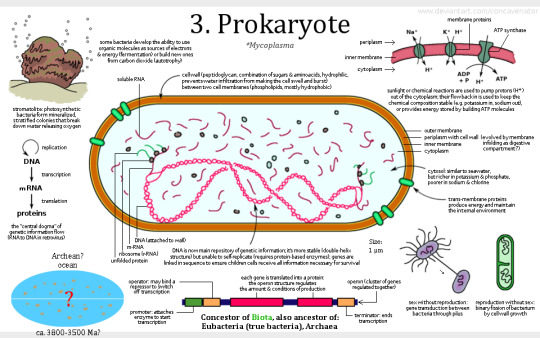
A generic bacterium-like prokaryote (from my Human Evolution infograph), probably pretty similar to LUCA.
To the most basic degree, this is what life on Earth is. Now for specifics. Under the cut, off we go!
At the highest level, cellular life is divided into three domains: Bacteria, Archaea, and Eukarya. The first two, which lack a cell nucleus and are collectively known as “Prokaryotes”, split from each other very early, while the Eukaryotes (much more complex cells with a nucleus and a bunch of internal organelles) probably arose later from an association of Bacteria and Archaea.
1. Bacteria or Eubacteria “real bacteria”: With few exceptions, most bacteria have rather boring shapes -- rods, threads, or balls -- but they make up for it with biochemical variety. Typical size may be 1-10 micrometers (= 1000ths of millimeter). If not of all life, two membranes on both sides of a cell wall is definitely the ancestral condition of bacteria. The cell wall is always composed of a complex protein-and-sugar material called murein or peptidoglycan, and keeps the cell in its proper shape. A flagellum (or more than one), a rather complex whip-like structure able to spin on its axis used by the bacterium to move around, can be anchored to the inner membrane. DNA is not enclosed in a nucleus, but forms a mass called nucleoid, which is often circular. There are only 9000 or so recorded species of bacteria (compare >300,000 of plants and over a million animals!); while this is certainly an undercount due to difficulty of observation, it’s actually possible that bacterial species do not split as readily as eukaryotes because of their constant exchanges of genes.
? 1a. Thermotogae “hot cloaks”: The first two clades are in uncertain position. They are usually considered basal to all other bacteria, because of extensive genetic differences, but this might be a consequence of being adapted to very unusual environments, as both live in hot water at near-boiling temperatures. Thermotogae are so named because their outer membrane fits loosely, and balloons out at each end. Their proteins and lipids are largely replaced by more heat-resistant equivalents, and their DNA is more tightly coiled.
? 1b. Aquificae “water-makers”: Their name indicates their most interesting feature: they get their electrons from hydrogen or thiosulfate, and by sending them over to oxygen, they produce water. Thermocrinus forms a sort of pink pond scum in the hot pools of Yellowstone; others live in deep sea vents.

Thermotoga maritima, with the characteristic ballooning membrane. (Brown 2014)
1c. Terrabacteria “land bacteria”: Interesting hypothesis in Battistuzzi & Hedges 2009: many particularities of this group -- the extreme radiation-and-drought resistance of Deinococcus, the loss of outer membrane in Posibacteria, the formation of drought-resistant spores of Cyanobacteria and Clostridia -- might be due to a move to the harsh environment of Precambrian dry land about 3 billion years ago, followed for most by a return to water.
1c1. Cyanobacteria “blue bacteria”: Commonly known as “blue-green algae”. If you’ve ever heard of a single bacterial subgroup, it’s probably these ones. These guys discovered chlorophyll some 2.5 billion years ago, and although they were not the first living beings to figure out photosynthesis, they were the first who discovered how to crack open water for its electrons, and thus the first who started producing oxygen. Most can also fix nitrogen from air, converting it into biologically more useful ammonia, but the reaction is inhibited by oxygen, so it's only performed by specialized cells called heterocysts. Much of green pond scum is cyanobacteria, formed by stringy colonies like Nostoc or Anabaena; the tiny Prochloroccus lives in the open ocean and is the most abundant photosynthesizer on Earth. The chloroplasts of plants used to be cyanobacteria as well; see part 2 or 3 for more on it.
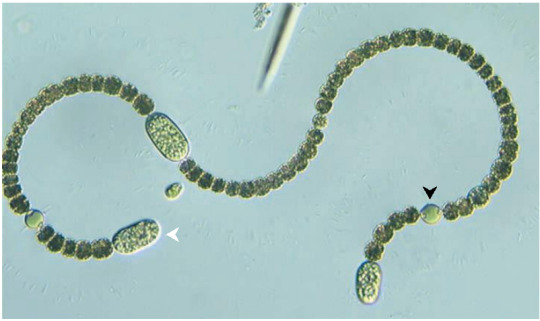
A filamentous colony of Anabaena (Cyanobacteria). Nitrogen fixation occurs in the heterocysts (black arrow); the larger cells are called akinetes (white arrow), a sort of spore able to survive starvation from which the colony can regrow. (Brown 2014)
1c2. Hadobacteria “underworld bacteria”: a rather extreme group, if a small one. Deinococcus radiodurans is famous as the most radiation-resistant organism on Earth, with its massively redundant DNA that allows it to repair even severe damage from radiation, as well as oxidation, drought, and mutagen chemicals. Other members of the group live in water at near-boiling temperature: Thermus aquaticus is important in biology, as it has a special heat-resistant version of DNA polymerase, used to multiply DNA samples in laboratories (the normal form of polymerase would be destroyed by the thermal cycles that are used to separate the DNA strands).

The fourfold Deinococcus radiodurans, first discovered in canned meat that was supposed to have been sterilized by radiation. Note the extremely thick cell wall. (Brown 2014)
? 1c3. Posibacteria: This group, which might or might not be slightly polyphyletic (i.e. with multiple origins), lost its outer membrane, and thus has its cell wall exposed. Gram coloration, which dyes the cell wall purple, sticks only to these bacteria, which are thus said to be “Gram-positive”. The lack of outer membrane makes them rely more on surface proteins and toxins for defense.
1c3a. Chloroflexi “green and bent”, also called “green non-sulfur bacteria” (see Chlorobia below). Photosynthetic, but they get their electrons from organic molecules, and thus don’t produce oxygen. They form thin filaments, not always green: Chloroflexus aurantiacus forms orange mats at Yellowstone.
1c3b. Actinobacteria “ray bacteria”: Mostly soil-dwellers. Streptomyces grows as a white “mold” on dirt and rotting wood: the earthy smell of the depths of a forest is actually the smell of Streptomyces! The same genus is also responsible for a great variety of antibiotics and antifungals, which it produces as weapon against competitors. Arthrobacter is another soil bacterium which, distinctively, grows sideways until it suddenly snaps in half. There’s a few pathogens too: Mycobacterium gives us leprosy and tuberculosis, and the club-shaped Corynebacterium diphtheria. On the other hand, the V-shaped Bifidobacterium is an important member of a healthy gut flora, and used in probiotics.
1c3c. Firmicutes “tough skins”: mostly fermenters, which use organic molecules as electron collectors and thus have no use for oxygen, although they may tolerate it. They often live in the skin, membranes, and gut of animals.
1c3c1. Bacilli “little sticks”: The name is clear enough: they mostly look like thin straight rods. Many can differentiate part of the cell into a super-resistent endospore, which can grow into a new cell should the old one die. Particularly important for us is Lactobacillus, which digests sugars producing lactic acid, and is employed to ferment cheese, yogurt, and krauts. It’s also the main inhabitant of the human vagina, which it protects from infection by acidifying it. Bacillus thuringiensis naturally produces an insecticide protein, used in agriculture as it’s harmless to vertebrates. Some Bacilli have taken a rounded form and may form clusters, such as the chain-like Streptococcus and the bunch-like Staphylococcus, both opportunistic pathogens of humans. “Clostridia” (“little spindles”) is a polyphyletic collection of species for whom oxygen is toxic, but which can survive it as endospores. The tetanus and botulinum bacteria, which last long in improperly preserved food and produce the deadliest organic toxins by weight, are both Clostridium.
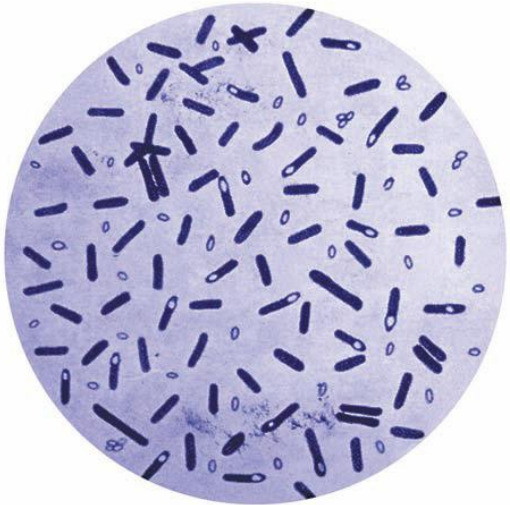
Clostridium botulinum (Bacilli). Endospores are visible as a growing swelling in some of the living cells as well as scattered outside. (Brown 2014)
1c3c2. Fusobacteria “spindle bacteria”: A rather small group. Fusobacterium resembles a Bacillus and may cause infections a bit all around the human body. You might have some on your teeth.
?1c3c3. Tenericutes/Mollicutes “soft skins”: These ones went further, and lost their cell wall as well, so their envelope is formed only by the inner membrane. They are intracellular parasites (i.e. they live inside host cells), which made it both possible and useful to discard their cell wall, as well as many metabolic genes that other species need to make their living. The smallest cellular organisms known, both in cell size and genome size, are here: the record belongs to Mycoplasma genitalium, which can infect the human urethra and can be as little as 1/5000th of a mm!
1d. Hydrobacteria “water bacteria”: The bulk of bacterial species, for which there was no land-colonization stage.
1d1. Spirochaetes “spiral thread”: Their form is very distinctive: coiled like a corkscrew. Their flagella are not external, but run between the two membranes, and cause the whole body to turn around its axis to swim. They are mostly found in soil -- and in the gut of termites, whom they help digest wood -- although they also include the agents of syphilis (Treponema pallidum) and Lyme disease (Borrelia burgdorferi).
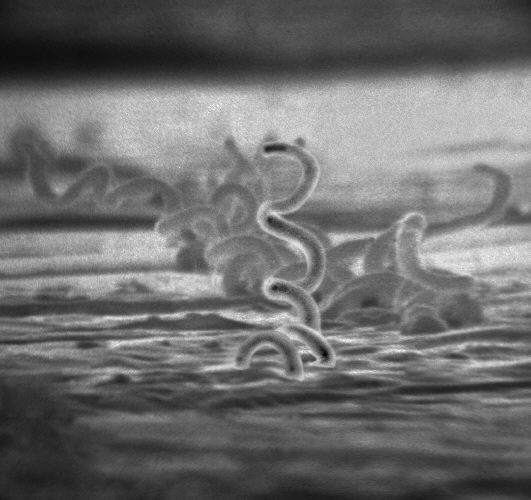
Treponema pallidum (Spirochaetes), the syphilis bacterium. (Wikipedia)
1d2. Planctobacteria.
1d2a. Planctomycetes “planktonic fungi”: they are usually stalked, and since they reproduce by budding they form colonies that look like a dandelion seedhead. Unlike most bacteria, their cytoplasm is divided in compartments, with a nucleus-like membrane surrounding their DNA -- a cutiously Eukaryote-like feature.
1d2b. Chlamydiae “little cloaks”: another intracellular parasite, like the Tenericutes. Chlamydia is a well known sexually-transmitted pathogen in humans and koalas, and it also causes eye trachoma. It’s a lazy organism: it doesn’t even bother to steal nutrients from the host to generate energy, but rather it directly steals energy, in the form of ATP molecules.
1d2c. Verrucomicrobia “wart microbes”: very similar to Chlamydiae. They mostly live in association with the cells of eukaryotes; the epixenosomes (defensive cell membrane organelles) of certain ciliate protists (see part 2) are probably symbiotic Verrucomicrobia. Prosthecobacter has genes for a protein very close to the tubulin of Eukaryotes, which is not found in other bacteria. These features made Devos (2021) suggest that both Archaea and Eukarya might have arisen together as the sister group of Planctobacteria, which would make Bacteria paraphyletic.
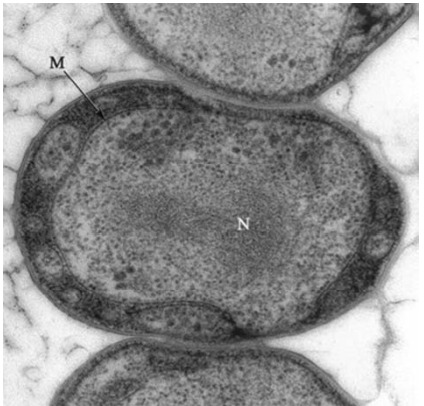
Isosphaera (Planctobacteria) and its curiously Eukaryote-like inyernal membrane (M) surrounding the DNA nucleoid (N). (Brown 2014)
1d3. FCB/Sphingobacteria
1d3a. Fibrobacteria “fiber bacteria”: very few species. Fibrobacter succinogenes is found in the rumen (the largest stomach) of ruminants such as cattle, helping them digest the ever-reluctant cellulose of grass.
1d3b. Chlorobia “green life”, also called “green sulfur bacteria”. They are photosynthetic, and get their electrons from sulfide; thus they don’t produce oxygen but pure sulfur, which builds up as tiny yellow granules under the cell wall.
1d3c. Bacteroidetes “bacteria-shaped”: a big group, and found a bit everywhere. Many live in animal guts, where they digest sugars; Bacteroidetes is one of the most important inhabitants of the human intestine. They include some of the few organisms who can digest chitin, the sugar polymer that forms the cell wall of fungi and the cuticle of insects.
1d4. Proteobacteria “shape-changing bacteria” (recently renamed Pseudomonadota, but that’s a terrible name): The Big One. They are especially good (more flexible enzymes, maybe?) at changing the input and output of the metabolic chain that transfers electrons from food to oxidizer, which means that for any chemical that occurs in nature you will find Proteobacteria living off it. This group is so vast and diverse that its sub-groups are simply indicated with Greek letters.
1d4a. Deltaproteobacteria: Many species of this group breathe sulfate as animals breathe oxygen (i.e. using it as an electron sink), and since they consume it their name sually starts with Desulfo-. It also includes the unusual Bdellovibrio, a flagellate bacterium that attacks other bacteria by penetrating between their cell membranes to suck nutrients from them. The sub-sub-group Myxobacteria is the closest prokaryotes ever got to multicellularity: when there is little food, individual Myxococcus cells swarm together to form gooey fruiting bodies, in which most cells die, but a lucky few turn into spores and are scattered in the hope of finding better environments.
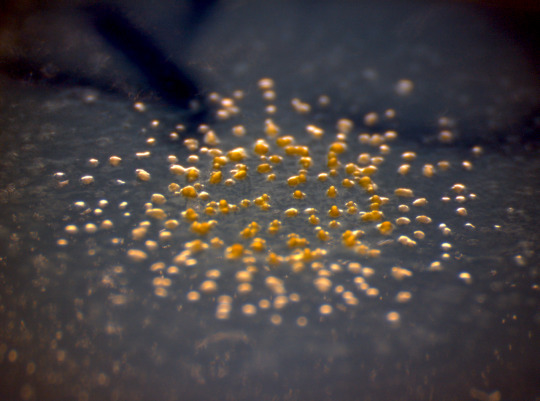
Fruiting bodies of Myxococcus xanthus. (Wikipedia)
1d4b. Epsilonproteobacteria: these mostly live in low-oxygen environments, such as the deep sea and the gut of vertebrates. They include the multi-flagellate Helicobacter pylori, which lives in human stomach acid and can cause gastric ulcera.
1d4c. Zetaproteobacteria: a single known genus, Mariprofundus, which lives in submarine volcanoes, where it takes electrons from the iron dissolved in seawater, oxidizing it and generating rust as waste.
1d4d. Alphaproteobacteria: a very important member is Rhizobium, a nitrogen-fixing bacterium (that is to say it can break apart the nitrogen gas in the atmosphere making it accessible to organisms) who lives as a symbiont in the roots of certain plants, most importantly beans. (Look for Fabales in part 4!) There’s also another group of intracellular parasites, including Rickettsia, which is transmitted by fleas or lice and responsible for typhus. A close relative of Rickettsia is Wolbachia, which is harmless to vertebrates but does dreadful things to arthropods (such as selectively kill males or turn them into females, because the parasite can only be spread by eggs and not by sperm). Many species have appendages, such as the multi-“armed” Ancalomicrobium, and Caulobacter, which has a fixed stalked form that can bud off mobile flagellate forms. Want more? Acetobacter ferments ethanol into acetic acid, turning wine into vinegar; Magnetospirillum concentrates iron oxide and uses it to perceive Earth’s magnetic field when it migrates. The mitochondria of eukaryotes (see part 2) probaly used to be Alphaproteobacteria as well.

The nodules on these alfalfa roots are filled with Rhizobium, who crack open molecules of nitrogen in the air (a very difficult reaction) turning it into ammonia, which is a source of nitrogen for plants. In exchange, the plant provides the bacteria with sugars produced by photosynthesis. (Wikipedia)
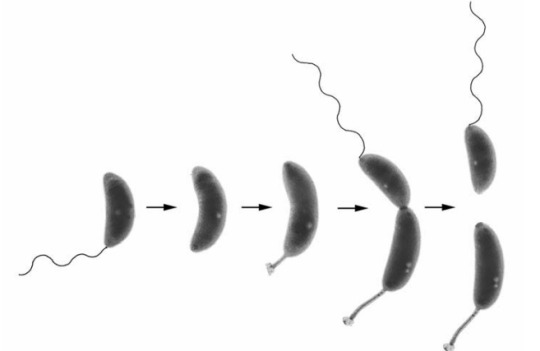
The lifecycle of Caulobacter crescentus, with a flagellate cell developing into a stalked cell that spawns more flagellate cells. (Brown 2014)
1d4e. Betaproteobacteria: these ones are very important in the cycles of nitrogen and sulfur: Nitrosomonas takes the ammonia produced by nitrogen-fixators and, by using it to reduce carbon dioxide (like plants do with water), it produces nitrogen oxides that can be taken up by plants.
1d4f. Gammaproteobacteria: the bacterium par excellence, Escherichia coli, first discovered in human feces and now the favorite model organism of many branches of biology, is here. Many of its relatives, the Enterobacteriales, also live in the gut of mammals; most are harmless, but they also include Salmonella. Others live in the stomach of ruminants, and help them digest cellulose. The Chromatiales, or “purple sulfur bacteria”, often share space with Chlorobia, using light of a different wavelength. Yersinia pestis and the comma-shaped Vibrio cholerae, the agents of bubonic plague and cholera, are also Gammaproteobacteria, as are those of tularemia and legionnaire’s disease, but really species of this group are everywhere in the water, air, and soil, and most will never bother you. Thiomargarita namibiensis, the largest bacterium known (almost a millimeter!) is also here.
2. *Archaea “ancient ones”: A strange thing, Archaea. Superficially, they look just like bacteria, and play many of the same roles; but they are built out of very different stuff. For example, their membranes are isopren ethers rather than acyl esthers like those of Bacteria and Eukarya (never mind what those are; this makes the membranes of Archaea much more resistant to heat). Ribosomes, transcription, and translation of Archaea are also different from those of Bacteria, but they are just like those of Eukarya. Like Gram-positive Bacteria, Archaea have only an internal membrane and a cell wall, but the wall is not made of murein (but rather “pseudomurein” or else proteins). The flagella also have a different structure and alimentation. Who knows what went on when the domains of life divided?
In general, Archaea are less diverse than Bacteria, and mostly live in environments that are hot, poor in oxygen, or otherwise extreme.
2a. Nanoarcheota “tiny ancient ones”: actually just a single species, Nanoarchaeum equitans. It’s an obligate symbiont of Ignicoccus hospitalis (see below), which hosts it within a special system of internal membranes -- something eerily similar to the endosymbiosis that produced Eukaryotes.
2b. *Euryarchaeota “broad ancient ones”: probably paraphyletic; a big part of the diversity of Archaea. A large part of them the relies on methanogenesis: they take electrons from hydrogen, and send them over to carbon dioxide, reducing it to methane. Termites and cows produce large amounts of methane because of Euryarchaeota in their gut, who took shelter there to flee from oxygen. Methanosarcina is used to treat wastewater, where it converts solid organic waste into gas. A different group live in hypersaline and often alkaline water; indeed Halobacterium salinarum was discovered in salted cod. Yet others are great lovers of boiling water, such as the wonderfully named Pyrococcus furiosus; the habitat of the cell-wall-less, amoeba-like Thermoplasma, discovered in coal mining waste, is less hot (”only” 60°C) but extremely acidic (pH 2, on par with stomach acid).
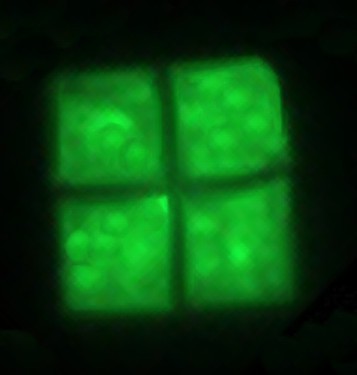
Haloquadratum walsbyi (Halobacteria), the only inhabitant of its natal magnesium-rich brine, as well as the only known square organism. (Wikipedia)
2c. TACK, or Thermoproteota sensu lato: the sister group of Asgardarchaeota down there, both arising from within the Euryarchaeota.
2c1. Thaumarchaeota “wonderful ancient ones”/Nitrososphaerota: a marine group very active in the nitrogen cycle. They seem to be the most important marine producers of the cobalt-containing vitamin B12, which no eukaryote can produce, but eventually finds its way through the food web.
2c2. Crenarchaota/Thermoproteota “hot shape-changers”: with different kinds of metabolism, but almost always involving sulfur. Sulfolobus is found in sulfurous boiling mud and bears “scars” where daughter cells budded off; Pyrodictium lives in deep-sea hydrothermal vents, growing at temperatures up to 115°C, at which water only stays liquid because of immense pressure! Ignicoccus is here as well.
2c3. Korarchaeota: a tiny group with very long, thin cells. Guess what? They live in hot water pools. Korarchaeum is a rare case of an organism that uses hydrogen ions (abundant in acid solutions) as electron sinks, thus producing hydrogen gas.
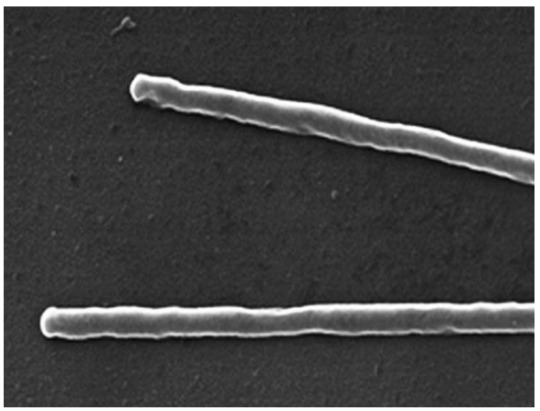
The elongated cells of Korarchaeum cryptophilum (Korarchaeota). (Brown 2014)
2d. Asgardarchaeota: Very recently discovered in a deep sea vent. Molecular studies show they are very close to the origin of eukaryotes, and may even be paraphyletic, with Eukarya arising from among them. Their subgroups are named after Norse deities (Lokiarchaeota, Heimdallarchaeota, &c). They look like fairly standard filamentous prokaryotes, but they share a lot of proteins with Eyukaryotes, as well as their actin-based cytoskeleton (see part 2).
3. Eukarya “good kernel”: lifeforms with a cell nucleus, most probably grown out of the Asgardarchaeota. We live here; see part 2!

Summary. Note that the divergence times (roughly based on Battistuzzi & Hedges 2009) are extremely tentative. Dotted lines represent uncertain lineages; the timescale is in million years before the present.
Sources
Battistuzzi & Hedges (2009), “A Major Clade of Prokaryotes with Ancient Adaptations to Life on Land” (link)
Brown (2014), Principles of Microbial Diversity, APM Press
Devos (2021), “Reconciling Asgardarchaeota Phylogenetic Proximity to Eukaryotes and Planctomycetes Cellular Features in the Evolution of Life” (link)
Doxey & al (2015), “Aquatic metagenomes implicate Thaumarchaeota in global cobalamin production”
Liu & al (2021), “Expanding diversity of Asgard archaea and the elusive ancestry of eukaryotes” (link)
Mendler & al (2019), “AnnoTree: visualization and exploration of a functionally annotated microbial tree of life” (Wiki summary)
Ruggiero & al (2015), “A higher level classification of all living organisms" (link)
Williams & al (2019), “Phylogenomics provides robust support for a two-domains tree of life” (link)
3 notes
·
View notes
Text
mRNA Translation
-- process of translating sequence of messenger RNA
-- messenger RNA = mRNA
-- turns sequence into amino acids
-- ribosome reads mRNA sequence in groups of three
-- three mRNA letters = codon
-- codons code for an amino acid
-- information begins in the DNA
-- transcribed into messenger RNA
-- translated from messenger RNA to protein
-- information is being transferred from one form to another
-- ribosome travels along the mRNA
-- detects the code as it goes
-- decides what amino acid to add based on the code
-- adds that amino acid to the polypeptide chain
-- this polypeptide chain becomes the protein
.
Patreon
#studyblr#notes#biology#bio#bio notes#biology notes#genetics#genetics notes#transcription#translation#mrna#messenger rna#rna#ribonucleic acid#dna#deoxyribonucleic acid#polypeptides#proteins#making proteins#life science#science#health science#medblr#medical notes#med notes#biochemistry#biochem#biochemistry notes#biochem notes#polypeptide chains
9 notes
·
View notes
Text
Tackling cancer at the nanoscale
New Post has been published on https://thedigitalinsider.com/tackling-cancer-at-the-nanoscale/
Tackling cancer at the nanoscale


When Paula Hammond first arrived on MIT’s campus as a first-year student in the early 1980s, she wasn’t sure if she belonged. In fact, as she told an MIT audience yesterday, she felt like “an imposter.”
However, that feeling didn’t last long, as Hammond began to find support among her fellow students and MIT’s faculty. “Community was really important for me, to feel that I belonged, to feel that I had a place here, and I found people who were willing to embrace me and support me,” she said.
Hammond, a world-renowned chemical engineer who has spent most of her academic career at MIT, made her remarks during the 2023-24 James R. Killian Jr. Faculty Achievement Award lecture.
Established in 1971 to honor MIT’s 10th president, James Killian, the Killian Award recognizes extraordinary professional achievements by an MIT faculty member. Hammond was chosen for this year’s award “not only for her tremendous professional achievements and contributions, but also for her genuine warmth and humanity, her thoughtfulness and effective leadership, and her empathy and ethics,” according to the award citation.
“Professor Hammond is a pioneer in nanotechnology research. With a program that extends from basic science to translational research in medicine and energy, she has introduced new approaches for the design and development of complex drug delivery systems for cancer treatment and noninvasive imaging,” said Mary Fuller, chair of MIT’s faculty and a professor of literature, who presented the award. “As her colleagues, we are delighted to celebrate her career today.”
In January, Hammond began serving as MIT’s vice provost for faculty. Before that, she chaired the Department of Chemical Engineering for eight years, and she was named an Institute Professor in 2021.
A versatile technique
Hammond, who grew up in Detroit, credits her parents with instilling a love of science. Her father was one of very few Black PhDs in biochemistry at the time, while her mother earned a master’s degree in nursing from Howard University and founded the nursing school at Wayne County Community College. “That provided a huge amount of opportunity for women in the area of Detroit, including women of color,” Hammond noted.
After earning her bachelor’s degree from MIT in 1984, Hammond worked as an engineer before returning to the Institute as a graduate student, earning her PhD in 1993. After a two-year postdoc at Harvard University, she returned to join the MIT faculty in 1995.
At the heart of Hammond’s research is a technique she developed to create thin films that can essentially “shrink-wrap” nanoparticles. By tuning the chemical composition of these films, the particles can be customized to deliver drugs or nucleic acids and to target specific cells in the body, including cancer cells.
To make these films, Hammond begins by layering positively charged polymers onto a negatively charged surface. Then, more layers can be added, alternating positively and negatively charged polymers. Each of these layers may contain drugs or other useful molecules, such as DNA or RNA. Some of these films contain hundreds of layers, others just one, making them useful for a wide range of applications.
“What’s nice about the layer-by-layer process is I can choose a group of degradable polymers that are nicely biocompatible, and I can alternate them with our drug materials. This means that I can build up thin film layers that contain different drugs at different points within the film,” Hammond said. “Then, when the film degrades, it can release those drugs in reverse order. This is enabling us to create complex, multidrug films, using a simple water-based technique.”
Hammond described how these layer-by-layer films can be used to promote bone growth, in an application that could help people born with congenital bone defects or people who experience traumatic injuries.
For that use, her lab has created films with layers of two proteins. One of these, BMP-2, is a protein that interacts with adult stem cells and induces them to differentiate into bone cells, generating new bone. The second is a growth factor called VEGF, which stimulates the growth of new blood vessels that help bone to regenerate. These layers are applied to a very thin tissue scaffold that can be implanted at the injury site.
Hammond and her students designed the coating so that once implanted, it would release VEGF early, over a week or so, and continue releasing BMP-2 for up to 40 days. In a study of mice, they found that this tissue scaffold stimulated the growth of new bone that was nearly indistinguishable from natural bone.
Targeting cancer
As a member of MIT’s Koch Institute for Integrative Cancer Research, Hammond has also developed layer-by-layer coatings that can improve the performance of nanoparticles used for cancer drug delivery, such as liposomes or nanoparticles made from a polymer called PLGA.
“We have a broad range of drug carriers that we can wrap this way. I think of them like a gobstopper, where there are all those different layers of candy and they dissolve one at a time,” Hammond said.
Using this approach, Hammond has created particles that can deliver a one-two punch to cancer cells. First, the particles release a dose of a nucleic acid such as short interfering RNA (siRNA), which can turn off a cancerous gene, or microRNA, which can activate tumor suppressor genes. Then, the particles release a chemotherapy drug such as cisplatin, to which the cells are now more vulnerable.
The particles also include a negatively charged outer “stealth layer” that protects them from being broken down in the bloodstream before they can reach their targets. This outer layer can also be modified to help the particles get taken up by cancer cells, by incorporating molecules that bind to proteins that are abundant on tumor cells.
In more recent work, Hammond has begun developing nanoparticles that can target ovarian cancer and help prevent recurrence of the disease after chemotherapy. In about 70 percent of ovarian cancer patients, the first round of treatment is highly effective, but tumors recur in about 85 percent of those cases, and these new tumors are usually highly drug resistant.
By altering the type of coating applied to drug-delivering nanoparticles, Hammond has found that the particles can be designed to either get inside tumor cells or stick to their surfaces. Using particles that stick to the cells, she has designed a treatment that could help to jumpstart a patient’s immune response to any recurrent tumor cells.
“With ovarian cancer, very few immune cells exist in that space, and because they don’t have a lot of immune cells present, it’s very difficult to rev up an immune response,” she said. “However, if we can deliver a molecule to neighboring cells, those few that are present, and get them revved up, then we might be able to do something.”
To that end, she designed nanoparticles that deliver IL-12, a cytokine that stimulates nearby T cells to spring into action and begin attacking tumor cells. In a study of mice, she found that this treatment induced a long-term memory T-cell response that prevented recurrence of ovarian cancer.
Hammond closed her lecture by describing the impact that the Institute has had on her throughout her career.
“It’s been a transformative experience,” she said. “I really think of this place as special because it brings people together and enables us to do things together that we couldn’t do alone. And it is that support we get from our friends, our colleagues, and our students that really makes things possible.”
#1980s#2023#2024#acids#Alumni/ae#applications#approach#Awards#honors and fellowships#biochemistry#blood#blood vessels#bloodstream#Born#Cancer#cancer cells#cancer treatment#career#cell#Cells#chemical#Chemical engineering#chemotherapy#coatings#college#Color#Community#Composition#Design#development
0 notes
Link
0 notes
Text
Fwd: Conference: Montreal.EvolutionBiologicalNoise.Jul26-30
Begin forwarded message:
> From: [email protected]
> Subject: Conference: Montreal.EvolutionBiologicalNoise.Jul26-30
> Date: 5 March 2024 at 06:13:26 GMT
> To: [email protected]
>
>
>
> Dear colleagues,
>
> We are excited to announce a symposium on EVOLUTION AND BIOLOGICAL NOISE at
> the 3rd Joint Congress on Evolutionary Biology in Montr�al, July 26 - 30,
> 2024.
>
> INTELLECTUAL MOTIVATION: Phenotypic variation is the substrate of evolution
> by natural selection. One source of phenotypic variation is biological
> noise, which can be generated both during reproduction (e.g. mutations) and
> development (e.g. mistranscription, mistranslation). Critically, the amount
> of phenotypic variation resulting from biological noise can be under
> heritable, genetic control. For example, DNA polymerase, RNA-polymerases
> and ribosomal protein alleles can differ in their accuracy of replication,
> transcription, and translation, respectively. This fact raises the
> possibility that the amount of biological noise, and hence, the amount of
> phenotypic variability in an evolving population may itself be subject to
> natural selection.
>
> TIMELINESS: Interest in the evolution of biological noise goes back at
> least 80 years, but stimulated by rapid technological advances (e.g.,
> single-cell phenotypic and genetic characterization), the past 20 years
> have seen an explosion of work. Today, biological noise is under active
> investigation in diverse intellectual communities including molecular
> modelling, gene expression and functional biology, developmental biology,
> transmission genetics, biophysics, systems and synthetic biology, and
> population genetics. There is also a growing appreciation of the role of
> biological noise in human health.
>
> OBJECTIVES: The purpose of this symposium is to draw workers together from
> across communities in order to develop a greater understanding of the
> empirical and conceptual similarities and differences among these many
> domains of inquiry into the evolution of biological noise. The organizers
> are especially interested in developing a deeper qualitative and
> quantitative understanding of the selective tension between the deleterious
> and beneficial consequences of biological noise.
>
> Questions? Contact the symposium organizers Nacho Bravo (
> [email protected]) or Dan Weinreich ([email protected]).
>
> Important dates:
> * Registration is now open.
> * Early-bird registration rates available until May 1.
> * Talk submissions due by May 1.
> * Conference dates: July 26 - 30. (Also perhaps of interest: the Montreal
> Jazz Festival opens July 27...)
>
> This is the link to the instructions for registering and submitting an
> abstract, and then choosing the symposium of your interest:
> https://ift.tt/kHOsYGJ
>
> Please note there is no risk in applying to symposia--talks not selected
> for symposia will be scheduled in concurrent sessions.
> https://ift.tt/kM9JQX1
>
> Please join us in making some (biological) noise this summer in Montr�al!
>
>
> [email protected]
>
> (to subscribe/unsubscribe the EvolDir send mail to
> [email protected]
0 notes
Text
Key Notes for NEET Biology- Principles of Inheritance and Variation.
Introduction to Principles of Inheritance and Variation in Genetics and Evolution:
The study of genetics and evolution unveils the intricate mechanisms governing the transmission of traits from one generation to the next, showcasing the principles of inheritance and variation. Inheritance refers to the passage of genetic information from parents to offspring, while variation encompasses the diversity observed among individuals within a population. These fundamental principles are central to our understanding of how living organisms evolve over time.
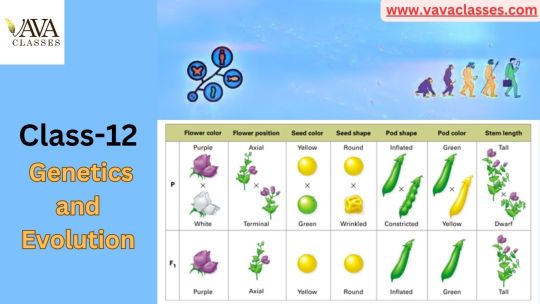
Genetics elucidates the molecular basis of inheritance, emphasizing the role of DNA, the genetic code, and the intricate processes of replication, transcription, and translation. Traits are inherited through genes, the units of heredity located on chromosomes, which determine an organism's characteristics. The principles of Mendelian inheritance, discovered by Gregor Mendel in the 19th century, lay the foundation for understanding how genes are transmitted through generations, defining the rules of dominance, segregation, and independent assortment.
Variation, on the other hand, is a cornerstone of evolution. Natural selection, proposed by Charles Darwin, operates on the variability present in populations. Genetic mutations, genetic recombination, and other mechanisms introduce novel variations, providing the raw material upon which natural selection acts. Those individuals possessing advantageous traits are more likely to survive and reproduce, passing on their beneficial genes to subsequent generations. Over time, this leads to the gradual accumulation of traits that enhance an organism's fitness and adaptation to its environment.
The principles of inheritance and variation intertwine to shape the genetic landscape of populations and drive the ongoing process of evolution. Understanding these principles is crucial for unraveling the complexities of life's diversity and the mechanisms underlying the perpetuation of genetic information across generations.
Below are condensed class 12 notes on the principles of inheritance and variation in genetics and evolution:
Mendelian Inheritance:
Gregor Mendel:
Father of genetics, conducted pea plant experiments.
Established three laws: Segregation, Independent Assortment, Dominance.
2. Law of Segregation:
Alleles segregate during gamete formation.
Each gamete receives one allele for each trait.
3. Law of Independent Assortment:
Alleles for different traits segregate independently during gamete formation.
4. Genetic Terminology:
Genes: Units on chromosomes carrying hereditary information.
Alleles: Different versions of a gene.
Genotype: Genetic makeup; Phenotype: Observable traits.
5. Punnett Squares:
Used to predict offspring genotypes and phenotypes in genetic crosses.
Non-Mendelian Inheritance:
1. Incomplete Dominance:
Heterozygotes exhibit an intermediate phenotype.
2. Codominance:
Both alleles in a heterozygote are expressed.
3. Multiple Alleles:
More than two alleles for a gene exist.
4. Polygenic Inheritance:
Traits influenced by multiple genes, leading to a range of phenotypes.
Chromosomal Basis of Inheritance:
1. Chromosomal Theory of Inheritance:
Genes are located on chromosomes.
2. Sex-Linked Inheritance:
Genes located on sex chromosomes (X and Y).
Hemophilia and color blindness are examples.
3. Linked Genes:
Genes located on the same chromosome tend to be inherited together.
Human Genetics:
1. Pedigree Analysis:
Charts representing family relationships and genetic traits.
Genetic Disorders:
Caused by mutations in genes.
Examples: Cystic fibrosis, Huntington's disease.
Molecular Basis of Inheritance:
1. DNA Structure:
Double helix composed of nucleotides.
2. DNA Replication:
Semi-conservative process ensuring genetic continuity.
3. Genetic Code and Protein Synthesis:
DNA codes for RNA, which codes for proteins.
Evolution:
1. Darwin's Theory:
Natural selection as the mechanism for evolution.
2. Evidence for Evolution:
Fossils, homologous structures, embryology, molecular biology.
3. Mechanisms of Evolution:
Natural selection, genetic drift, gene flow, mutation.
4. Speciation:
Formation of new species due to isolation and adaptation.
5. Hardy-Weinberg Equilibrium:
Conditions for a non-evolving population.
These class 12 notes provide a concise overview of the key principles in genetics and evolution. Further exploration and in-depth study can be done based on these foundational concepts.
#science#9thclass#11thclass#botany#biology#chemistry#class 8#foundation#11th class#vavaclasses#class 12#cbse#english
1 note
·
View note
Photo
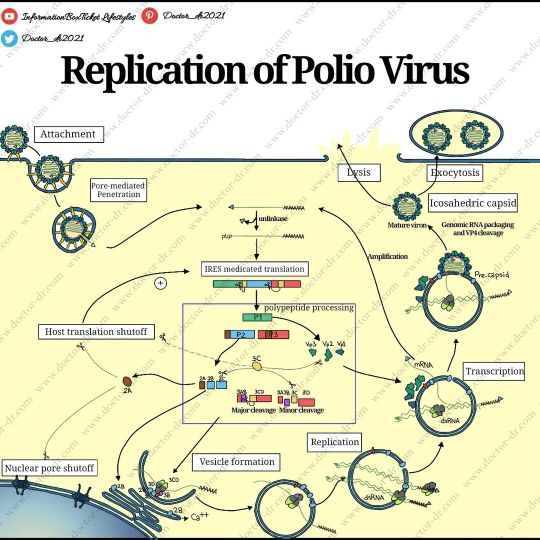
Poliovirus replication is a complex process that involves hijacking host cell machinery and manipulating it to create new virus particles. Once the virus enters the host cell, it takes over the cellular machinery and begins to replicate its RNA genome. The replicated RNA is then translated into viral proteins that assemble into new virus particles. This process is fascinating and a critical aspect of poliovirus infection. Understanding the intricacies of poliovirus replication is essential to developing effective treatments and vaccines to combat this deadly virus. Stay tuned for more updates on the latest research and breakthroughs in the fight against polio! . . . Don't forget to like, share and follow 🦠 . . . For more lecture notes on med vist our website LINK IN BIO 😍🧪 . . You can subscribe to our channel InformationBoxTicket Lifestyles on YT 😍 . . #doctor_dr2021 #informationboxticketlifestyle #doctor_dr #medstudent #microbiologist #microbiology101 #microbiology #sciencefacts #info #aiou #biology #lectures #poliovirus #replication #virology #science #research #medicine #health #vaccine #treatment #replicationofvirus #virus #virologist #viralreplication #prevention #publichealth #fascinatingscience #lifeofvirologist #freelancers (at Allama Iqbal Open University) https://www.instagram.com/p/Cpmm-MujvGH/?igshid=NGJjMDIxMWI=
#doctor_dr2021#informationboxticketlifestyle#doctor_dr#medstudent#microbiologist#microbiology101#microbiology#sciencefacts#info#aiou#biology#lectures#poliovirus#replication#virology#science#research#medicine#health#vaccine#treatment#replicationofvirus#virus#virologist#viralreplication#prevention#publichealth#fascinatingscience#lifeofvirologist#freelancers
0 notes
Text
Mesenchymal Niche-Derived Neuregulin-1 Hard disks Intestinal Originate Cellular Growth and also Regeneration of Ruined Epithelium
This specific model ended up being examined by simulating WHZ modify had to restore an average WHZ submitting within a check populace. Setting: Any rural area regarding Democratic Republic with the Congo with a substantial frequency involving undernutrition. Subjects: Children beneath Several years of aging. Results: To regenerate an ordinary submitting for the whole populace, the particular WHZ coming from all youngsters ought to be altered. The required WHZ change of each and every personal needs to be higher when the persons initial WHZ will be low, if the suggest WHZ from the entire population is lower and also, which are more wasted individual, if the alternative regarding WHZ and WHZ difference in the population tend to be high. With all the advised style in the simulator on the analyze inhabitants led to a WHZ submission close to the expansion common. Conclusions: To bring back a normal WHZ submitting throughout thrown away communities, dietary courses need to protect the full populace with a greater extra weight in places that suggest WHZ is minimal.We now have earlier noted that will relaxin (Rln) phrase from the ovary will be upregulated by simply orthodontic tooth movement. This research ended up being carried out to evaluate the particular speculation that will Rln family members proteins (Rxfps), the particular G-protein-coupled Rln receptor, will be caused in periodontal soft tissue (PDL) tissue for you to regulate your molecules involved with periodontal tissue upgrading although applying biophysical pressure. Subjects were equipped with orthodontic appliances to analyze modifications to Rxfps in vivo. A great inside vitro biophysical force analysis had been performed to measure how much Rxfp One courier RNA (mRNA) within major human PDL cells. The amount of Rxfp Two transcribing and translation improved in a time-dependent method through teeth movements. Rxfp 2 has been localized from the PDL through immunofluorescence. Throughout vitro examines said the degree of Rxfp 1 mRNA throughout PDL cells increased significantly with both compression setting along with anxiety power. The degrees regarding matrix metalloproteinase (MMP)-1, MMP-2, interleukin-6, and also vascular endothelial growth factor mRNA, that are necessary for periodontal cells redesigning, in addition transformed below force program and Rln remedy. PDL cellular material answered Rln in order to regulate effector molecules with regard to gum tissue upgrading simply by upregulating Rxfps expression with a biophysical power. Rln and Rxfps serves as the PDL revenues compound complicated to control orthodontic enamel activity.Medical study information have supported the security and efficacy involving drug-eluting stents (Plusieurs) within the treating sufferers Selleck Urolithin A using ST-segment top myocardial infarctions (STEMIs), but modern "real-world" computer registry files regarding the late basic safety profiles regarding DES are restricted. This particular possible registry-based research integrated One,569 sequential unselected patients along with STEMIs whom went through emergency major percutaneous coronary input coming from Present cards Mid 2001 for you to Dec 09. In the research cohort, 2 hundred people (14.
#Apoptosis Compound Library#JAK inhibitor#AM1241#Bicalutamide#Lovastatin#BAY-293#RGD#Isoxazole 9#PJ34#Tubacin#Tenofovir#Urolithin A#PP2#BIBR 1532#RG108#Pazopanib#Coelenterazine#Resiquimod#Spautin-1#PF-573228#SCH900353#compound 78c#NSC 10483#MMAE#RP 13057#CGS 20267#4-MU#NSC-67574#LY-231514#TP-0903
1 note
·
View note
Text
Alive or Not?
An Alien, A Robot, or
Just something from out of this world!
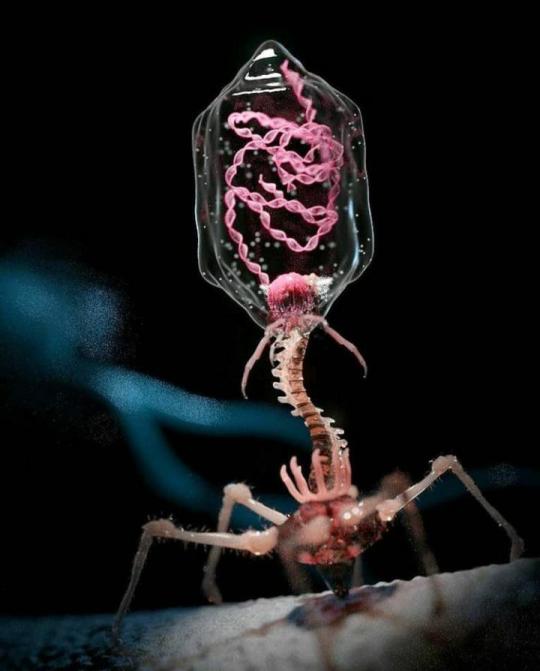
What do you think this is?
I’ll give you a few hints:
They are not alive, well at least not based on present scientific teachings. Yet, they can invade our bodies and even insert their genetic code into ours.
…Yes, they have their own genetic code!
There is no escaping them! …. They are everywhere! …Inside of us… on our bodies….
They are on the surfaces we touch… in the food we eat… the water we drink…. the air we breathe….
What comes to mind?
If you guessed viruses, you are right!
If you didn’t, no worries.
Either way, let’s explore some more.
Viruses are found in every environment on earth!
And not only that, they have the most abundant source of genetic material in our planet. (Márquez 2021)
So, what are viruses anyways?
Viruses are microscopic obligate parasites - meaning, they can only reproduce inside their host (Flint et al., 2020).
As mentioned before, viruses are not thought to be alive. You may ask, why is that so?
What is considered to be living?
There is a list of characteristics and attributes that scientists have conventionally used to distinguish living organisms from non-living things.
Living organism are made up of one or more living units (a.k.a cells) and carry out biological processes such as energy metabolism, homeostasis, responding to stimuli, autopoiesis and growth (Britannica, 2022).
The latter is one of, if not, the major reason why viruses are not considered to be living organisms. That is, because they are not able to reproduce without a host cell (Márquez 2021).
You see, in spite of having genetic material (DNA or RNA), viruses cannot reproduce on their own and as such, are reliant on their host organism to make more of themselves.
In the Molecular Biology Reports entitled, “What is Life, the author argued that viruses, being obligate intracellular parasites, that this should not disqualify them from being considered living organisms. The reason he gave is that viruses, like other parasites, are using their host for their benefit and that’s just their survival strategy (Márquez 2021). I very much agree with his statement. That sounds like the textbook definition of a parasite to me. Wouldn’t you agree?
There is a growing number of scientists in support of this unconventional idea, that viruses are alive (Márquez 2021).
A catalyst for this unconventional view of viruses is the recent discovery of mega viruses. Prior to the discovery of the Mimivirus, viruses were thought to be very small and simple. Also, with new techniques such as genomic sequencing, a technique that is used to determine the genetic sequence of the entire DNA at a single time (CDC, 2019), Virologist can now confirm that viruses are not simple (Márquez 2021).
Since the discovery of the Mimivirus, other mega viruses continue to be discovered.
Let’s take for example, Megavirus Chilensis. As the name suggest, this is a giant virus. It was discovered off the coast of Chile, where it was isolated from its host amoeba, Acanthamoeba. Megavirus Chilensis has the largest known viral genome - a whopping 1,259,197 base pair genome that codes for 1,120 proteins (Legendre et al, 2012).
What is even more surprising is that Megavirus Chilensis, as with its closest relative the Mimivirus, genes encode key elements of the translation apparatus, a property that is long thought to be a trademark of cellular organisms (Legendre et al., 2012).
These giant viruses are really breaking all the rules! Aren’t they?
Mimivirus was noted to encode 4 aminoacyl tRNA synthetases for the amino acids Methionine, Tyrosine, Cysteine and Arginine. Which means that, though viruses are reliant on their host cell to copy the different parts of their body and assemble multiple copies of themselves, some also have genes that code for the important enzyme aminoacyl tRNA synthetases, which is vital to protein synthesis. Viruses possibly making their own proteins!? Wouldn’t that be something?
As virologist study and learn more about these mind-blowing components of viruses, it really forces us to rethink our definition for living organisms and the current classification of such organisms. The discovery of the Mimivirus has truly led to a breakthrough in the definition and understanding of viruses (Colson et al, 2012).
What do you think? Should the definition of living organisms and its classification be altered to accommodate Viruses being defined and classified as living organisms. That being the case, would viruses be the 4th domain of life (eukaryotes, bacteria and archaea being the other three) given its unique characteristics?
Resources
Márquez-Gomez, J. (2021). What is Life. Molecular Biology Reports. https://www.ncbi.nlm.gov/pmc/articles/PMC8376694/. Mol Biol Rep. 2021; 48 (8): 6223-6230. Published online2021 Jul 27. doi:101007/s11033-discovery-of-the-giant-mimivirus-14402410/
Flint, J, Racaniello R.V., Rall, F. G., Hatziioannou, T., and Skalla M. A. (2020). Principles of Virolog, Vol 1 Molecular Biology. Fifth Edition. American Society for Microbiology. Printed in the United States of America. Pages 2 – 23.
Britannica.com. (2022). Life – Genetics. Https://www.britannica.com/science/life/Genetic
CDC. (2019). What is Genomic Surveillance? CDC.com. https://www.cdc.gov/coronavirus/2019-ncov/variants/genomic-surveillance.html
Legendre, M., Defne, A., Abergel, C., and Jean-Micahel, C. (2012). Genomics of Megavirus and the elusive fourth domain of Life. Communicative & Integrative Biology, 5:1, 102-106, DOI: 10.4161/cib.18624. https://www.tandfonline.com/doi/full/10.4161/cib.18624
Colson, P., Lamballerie, X., Fournous, G., and Raoult, D. (2012) Reclassification of Giant Virusses Composing a Fourth Domain of Life in the New Order Megavirales. PubMed DOI: 10.159/000330562. https://www.researchgate.net/publication/224052321_Reclassification_of_Giant_Viruses_Composing_a_Fourth_Domain_of_Life_in_the_New_Order_Megavirales
0 notes
Text
one of the things I like best about ART's choice of hiding space is that referring to its kernel as a recipe is such a good joke if you've thought deeply about the nature of development and identity and becoming a person. Especially in light of SecUnit's bugfuck idea to use its own kernel as the center of, essentially, a bot designed to be killware. (Even more than constructs, bots are not their bodies; note that the difference between a bot and a drone is the number of artificial intelligences controlling and inhabiting any number of "bodies". The bot is the intelligence, not the chassis, and we see from ART's reaction to MB's proposal that it has clearly thought deeply about this.)
But I was explaining the joke: DNA is often referred to as a blueprint by people who are not geneticists, because they think that DNA contains if not the self (lol no) but at least a set of complete instructions for creating the self. This is a terrible analogy, because blueprints are designed to be invariable from construction to construction. If you have the blueprints, and the structure is competently executed, the outcome should be the same every time, no matter who is constructing it or what the conditions are.
DNA in the context of development is not very much like this at all. For one thing, at any given time you're only bothering to read part of it, and you're scrunching up the rest like Christmas lights tangled together in the attic. More seriously, all biological organisms are fundamentally products of both nature and nurture (defined as "the experience of passing through the process of developing"; i.e. everything after the blastocyst starts dividing, technically); you do not get an organism at all without both things acting in concert. The process of making a new organism helps define what that organism becomes.
In the case of embryonic development, often you need specific contributions of genetic material and provisions from one or both parents or the budding embryo never gets off the ground. The code for that provisioning, though, isn't written in the genome of the blastocyst at all--usually it's encoded within the genomes of one or both parents. Genes like chicken eggshell color, for example, work like this: it is entirely possible, and indeed quite common depending on the cross, for a pullet chick to hatch from a white egg while carrying a genotype that specifies that the hen that chick grows up to be will lay only blue eggs! Now consider that maternal egg provisioning, say, can affect much more important qualities of development and growth than the color of an egg shell.
On an even more basic level than that, DNA works by being transcribed into RNA, which is then translated into proteins. Except that the function of some of those proteins is to control transcription or translation of other proteins, such that the eventual expression of any single protein is a function not ONLY of the code for that protein but ALSO of the expression patterns of a whole array of other proteins, some of which respond to internally controlled changes and some of which are acting in response to the environment.
So DNA is much more like a recipe than a blueprint: the final end product of the cake will be defined not only by whether you follow the instructions on the label, but also things like whether you folded the batter correctly and what the humidity level is in the room and how far you are above sea level and just how long you leave the cake in the oven. The final cake is a dialogue between the recipe and the process of actually putting the cake together.
(The earliest use of this metaphor I'm aware of, offhand, is in The Science of Discworld (1999), which is even after twenty years a marvelous and thorough journey through a number of fascinating biological concepts using the framework of the wizards of the Disc studying the bizarre "Roundworld" they have discovered or perhaps created. So: this metaphor has been out and about in SFF circles now for twenty years, which certainly impacts the likelihood that Wells is invoking it intentionally.)
This is even more true when you consider the development of the brain, which is after all continually learning. Certainly current artificial intelligence research emphatically tells us that the process of developing is crucial to being able to produce any kind of sophisticated intelligence. Our memories and the concepts that we learn and internalize about how the world works shape our reactions, responses, and motivations to interact with the world around us.
So of course ART, who is a) an incredibly sophisticated machine intelligence, b) the experimental child of a university project, c) the sole operator of a fully functional MedSystem designed to care for human bodies, and most importantly d) an insufferable fucking know it all possessed of endless curiosity, is likely to have encountered discussions like this before, and probably the analogy itself. Most clever, inquisitive children like to ask their parents about themselves and how they are alike and different to other people, and I don't see that an artificial intelligence should be any different. And that analogy is only getting more and more common among genetics teachers, textbook writers, and science educators in recent years.
A kernel isn't quite like a recipe that way, but I'm pretty sure that the joke of hiding an essential but not wholly self contained piece of oneself, like a seed, in a recipe menu absolutely occurred to ART from all these analogies about cake making. Of course ART itself would probably have encountered the metaphor as being more of a way to understand cake baking--which, of course, it has probably done relatively infrequently on a personal level, especially as human food isn't especially salient to it--than to understand the complex flexibility of learning systems.
Anyway then you have Murderbot flailing in to all of this and insisting that it is defined purely by its meat self, like a human, and not at all like a bot by the shape of its learning and the ability modules it has access to.
112 notes
·
View notes
Text
I don't know how many of you may have already heard about this on Twitter, but because most of you may not have heard yet, and some may want more context for what's going on, I'm going to make an important statement that I hope all of you read carefully.
Chiaki J Konaka is an alt-righter
BIG UPDATE: A FULL TRANSLATION of Konaka’s blog posts has been uploaded. While my post works as a TL:DR; simplification of it, I implore all of you to go read the full document and sharing it. I will also note that this document was my original source for the post, simplified as it may be.
For the past few months Konaka has been spreading alt-right conspiracy theories on his blog. Because the blog is in Japanese most people can't read it, and as such this situation has stayed unknown by the larger (western) fanbase, until now that is, as the Tamers audiodrama from DigiFes has been uploaded with subtitles.
There is currently no public, full-translation of his blog posts as the fanbase's translators don't want to let his words have a larger reach, but to give an idea of the kinds of things he's been saying, here's a non-comprehensive list:
promoted James Corbett, talkRADIO and UK Column, all of which are alt-right "news outlets" (all of which have been deplatformed to various degrees)
complained about Internet platforms "shutting down different perspectives and opinions" (see above)
went on a conspiratorial tangent about the World Economic Forum (where a bunch of rich people come together to discuss what should be done under theoretical global emergencies) and how "they announce that these things will happen" (using COVID-19 as an example of a crisis that was "planned and announced")
compared the COVID-19 vaccine to a fictional vaccine from his previous work (Devilman Lady) that was a 'government enforced vaccine that would mutate people by modifying human RNA'
During this year's DigiFes, there was Tamers audio drama written by Konaka being read at at the event, and it deeply reflect's Konaka's "views". Fansubs of the audio drama went up last night and screenshots of it are already floating around on Twitter, so those who want to see it can seek it out. For those who don't, the drama was essentially about "political correctness" and "cancel culture" shutting down "different perspectives" and "going as far to delete people's voices".
Because of the audio drama and the screenshots of it spreading, I thought it was important for you all to know, for absolute certain, that the audio drama wasn't about "fake wokeness" hurting marginlized people, but rather, it is about anti-vaxxers and alt-righters being deplatformed.
This is a sad, awful situation and a god-awful thing to find out about, but I wanted to make sure that all of you get better context and find out about anywhere else but on Twitter.
As one final note, there is a possibility Konaka could be writing Ghost Game as well. That is still unconfirmed, we don’t know anything about Ghost Game’s staff right now (Konaka has just been saying things that could mean he’s writing for a new anime). We can all pray that is not in Ghost Game’s staff at all, but if he does turn out to be on GG's staff, I do want everyone who wishes to watch the series to be wary of the messages he might be trying to send through it.
As for myself, if Konaka is writing Ghost Game, I will not be watching it.
I will not give him and his ideology a platform and will not promote it.
EDIT: He’s not on Ghost Game’s staff
637 notes
·
View notes